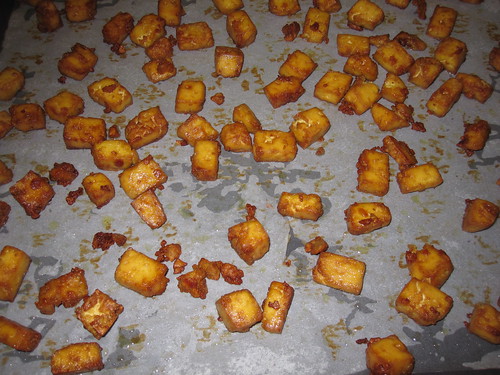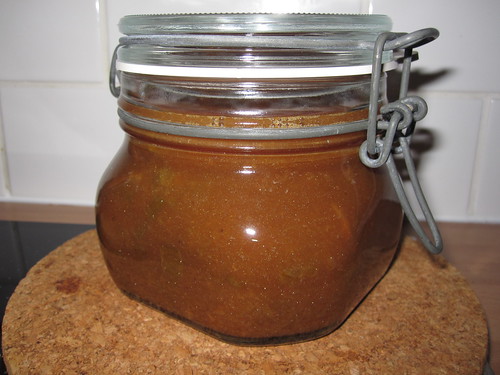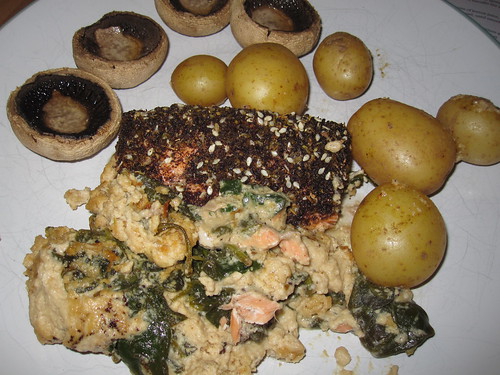
A couple of years ago, a lemon balm plant had seeded itself next to our pond. I like the smell of this herb and left it there. Chatting to a neighbour, she confirmed that it probably came from her garden. What we hadn't realised is that lemon balm is from the mint family, which means it is quite rampant and can take over fairly quickly.
A few years before that, we made an attempt to rejuvenate our little pond and purchased several pretty looking aquatic plants, one of which was water mint. Again, this plant took over the pond and seems to have no issues growing on land either. Lundulph is not too happy about either and I humoured him, by removing some of the lemon balm seedlings in the flower patch around the pond now that we're in a lockdown. Thus I liberated a rose bush, my beloved ramsons and some lovely Welsh poppies.
But the lemon balm got me wondering and googling on what can be done with it. Mostly it is tea, which I tried last week - it was quite nice, but the plant is way too large for us two to use up. I've also read that lemon balm is not suitable for drying. In Sweden it is used as decoration to desserts, very much like you'd do with mint leaves in the UK. It's also nice to put in drinking water now and then as well. But I managed to learn what lemon balm is in Bulgarian, and I searched for recipes, which resulted in this one (in Bulgarian) that seemed decent enough to try. So as it's Sunday today, I made it into our roast lunch. I did some tweaks to the recipe, the original instructions were on the sparse side.
Ingredients
a handful of lemon balm leaves
a handful of mint leaves
a handful of wild garlic leaves
a handful of curly parsley
a handful of dill
2 poussins at 500 g each
salt and pepper
50 g butter
baby potatoes
chestnut mushrooms
50 g butter
3 tbsp plain flour
4 dl semi-skimmed milk
1 dl whipping cream
nutmeg
Method
- Wash all the herbs well and shake off the excess water, then cut them finely and mix together in a bowl.

- Wash the poussins and pat them dry with kitchen paper, then sprinkle with salt and pepper inside the cavity.
- Stuff the herb mixture into the cavities, but keep about a dl of the herbs aside for the sauce.
- Tie together the legs of each poussin, so the herbs don't fall off and rub butter over the breasts, legs and wings.
- Place the poussins in a roasting bag and season, then tie the bag, making sure to leave space or it to expand.

- Wash the baby potatoes and place in a pot ready to steam.
- Peel the mushrooms and line up on a roasting rack, then sprinkle some salt on each.
- Pre-heat the oven to 180 °C fan. Once hot, place the poussins to roast for 55 minutes.
- After 15 minutes, put the potatoes on to steam and after a further 10 minutes, put the mushrooms in to roast as well.
- When there are about 10 minutes left, heat up the butter in a saucepan.
- Once it bubbles, add the flour and stir with a wooden spoon to soak up the butter and fry it for a couple of minutes while constantly stirring.
- Slowly start adding the milk, a little at a time to prevent the saucepan temperature to drop too much and stir it in. It will look like a stretchy dough at first, but will eventually become a batter and finally a sauce.
- After the mixture has turned into a sauce, add the cream, season with salt and pepper and grate a little nutmeg into it.
- As it starts to bubble, stir in the remaining herb mixture.
- When the time is up, carefully remove the poussins in their roasting bag from the oven, then grabbing the top of the roasting bag, hold it over the saucepan, incline it towards one of the corners, then carefully partially snip this corner and let the roasting liquid drain into the sauce, while stirring.
- Once all the liquid is drained, let the poussins rest a couple of minutes, covered under a towel.
- Take out the poussins from the roasting bag and carve up onto pre-heated plates. Serve with the potatoes and mushrooms and pour the sauce on top.
I don't know if any of the herbs permeated the chicken meat, but it was delicious. Lundulph concurs - a small but very nice chicken. The poussins were so tender and juicy. I'm also quite pleased with the sauce. We ate one of the poussins and kept the other one for next week. For dessert we had some of the lovely rhubarb ice cream. I really must start using my garden more and pick the stuff that grows on its own with no effort on my part.








